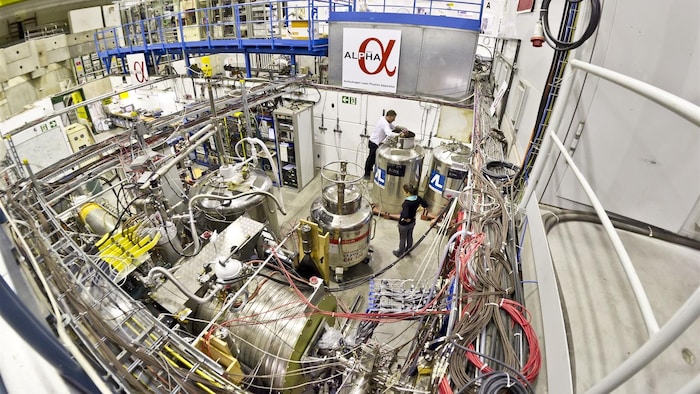Open in full screen mode The CERN team is preparing the ALPHA- experiment G, which traps around a hundred atoms of antihydrogen. Agence France-Presse Feature being tested Log inCreate my account Speech synthesis, based on artificial intelligence, makes it possible to generate spoken text from 'a written text. Antimatter, these symmetrical particles of matter that surround us, is no exception to the rule that all body experiences the force of gravity, according to the first experiment to observe it, announced the European laboratory CERN. Physicists expected it, Einstein had theorized it in 1915, but the experiment is a major step: it excludes the possibility that the force of attraction, exerted by the Earth on objects on its surface, pushes the antimatter particles upward. The theory is that the Big Bang, 13.8 billion years ago, produced as much matter as antimatter. However, there is almost nothing left of the latter today. Theorists think that matter and antimatter have destroyed each other mutually, but not completely. Mostly matter remained, which constitutes 5% of the Universe as we know it. We don't know why nature chose matter over antimatter, Jeffrey Hangst, a member of the ALPHA collaboration at CERN in Geneva, who led the experiment, told AFP. /p> The experiment verified that antimatter was indeed subject to the force of gravity, taking inspiration from Isaac Newton, who conceived his law of universal gravitation after receiving an apple on the head, according to legend. In the case of antimatter, why not let it go and see what happens? adds the physicist. In nature, antimatter appears briefly in the form of particles generated in very energetic objects like cosmic rays, but also in the experiments carried out by CERN, which in 1996 produced its first antimatter particles in the form of antihydrogen atoms. These objects are tricky to handle. Their contact with matter leads to the annihilation of both (matter and antimatter) in a flash of energy. That's the only advantage with antimatter: when you lose it, you know it, explains Jeffrey Hangst. The ALPHA team used a 25-centimeter vertical cylinder, equipped with magnets at the ends: a magnetic trap, called ALPHA-G, which traps around a hundred atoms of x27;antihydrogen. By varying the intensity of the magnets, the researchers allowed the atoms to escape and escape ;be counted thanks to the light flash of their annihilation when they came into contact with matter. About 80% of the antihydrogen atoms came out from the bottom, in a similar proportion to that of hydrogen atoms. The result, published in the journal Nature (New window) (in English), shows that antimatter falls like matter under the effect of the force of gravity. p> Even if, specifies Mr. Hangst, the experiment does not prove that antimatter behaves exactly like matter. For Marco Gersabeck, a CERN physicist who was not involved in this study, this discovery is a major step in understanding antimatter. It marks just the beginning of a new era of precision measurements in this field. Physicists work from several angles of attack: relying on the Large Hadron Collider (the LHC), which explores the world of strange particles, or with an experiment aboard the International Space Station (ISS), which tries to detect antimatter particles in cosmic rays. But do we know why the world we know contains matter and not antimatter? Mystery, responds to AFP Harry Cliff, physicist at CERN. They should have annihilated completely at the beginning of the Universe. Our existence suggests that there is something beyond our control.
Antimatter is subject to the force of gravity, like matter

